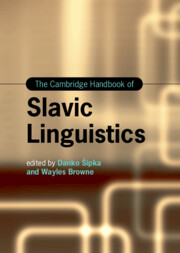Book contents
- The Cambridge Handbook of Slavic Linguistics
- Cambridge Handbooks in Language and Linguistics
- The Cambridge Handbook of Slavic Linguistics
- Copyright page
- Contents
- Figures
- Tables
- Contributors
- Introduction
- Part 1 Prosody and Phonology
- 1 Word Stress
- 2 Vocalism: The Vowels
- 3 Consonantism: The Consonants
- 4 Syllable Structure
- 5 Phonologically Conditioned Alternations
- 6 Prosodic Reflexes of Information Structure
- Part 2 Inflectional and Derivational Morphology
- Part 3 Syntax
- Part 4 Lexicon
- Part 5 Sociolinguistic and Geographical Approaches
- Part 6 Experimental and Quantitative Approaches
- Name Index
- Subject Index
- References
3 - Consonantism: The Consonants
from Part 1 - Prosody and Phonology
Published online by Cambridge University Press: 16 May 2024
- The Cambridge Handbook of Slavic Linguistics
- Cambridge Handbooks in Language and Linguistics
- The Cambridge Handbook of Slavic Linguistics
- Copyright page
- Contents
- Figures
- Tables
- Contributors
- Introduction
- Part 1 Prosody and Phonology
- 1 Word Stress
- 2 Vocalism: The Vowels
- 3 Consonantism: The Consonants
- 4 Syllable Structure
- 5 Phonologically Conditioned Alternations
- 6 Prosodic Reflexes of Information Structure
- Part 2 Inflectional and Derivational Morphology
- Part 3 Syntax
- Part 4 Lexicon
- Part 5 Sociolinguistic and Geographical Approaches
- Part 6 Experimental and Quantitative Approaches
- Name Index
- Subject Index
- References
Summary
This chapter examines consonants in Slavic languages primarily from a synchronic perspective. I begin by reviewing the consonant inventories. Key properties of the inventories are secondary palatalization, a large inventory of coronal fricatives and affricates, and a voicing contrast in obstruents. The remainder of the chapter reviews four types of consonant patterns: palatalization, voicing, other local alternations, and long-distance alternations. Palatalization is inherited from Proto-Slavic, but the contemporary languages differ in terms of segments undergoing it, morphological triggers, and phonological conditioning. Slavic voicing alternations offer typological insight into the extent of cross-linguistic variation. The key differences are in final devoicing, directionality, and participation of sonorants. Slavic languages also exhibit limited place assimilation, dissimilation, and consonant decomposition. As for long-distance patterns, I review both assimilatory (sibilant consonant harmony) and dissimilatory (consonant co-occurrence restrictions) phenomena in two Slavic languages.
- Type
- Chapter
- Information
- The Cambridge Handbook of Slavic Linguistics , pp. 45 - 63Publisher: Cambridge University PressPrint publication year: 2024



